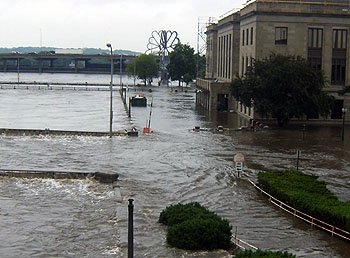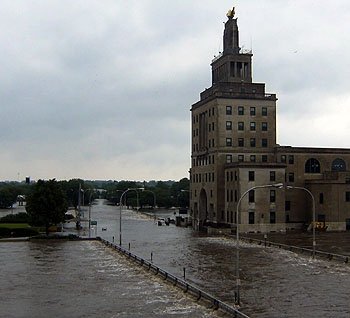There were valuable parallels between the flooding in Iowa and Hurricane Katrina. But the media looked in the wrong places
The distinctive beep of an car alarm being activated prompted many in southwest Cedar Rapids front yards to slow their flood cleanup and watch a man exit a vehicle with out-of-state license plates.
“He set his car alarm?” asked a woman as she carried one end of a friend’s soggy and smelly sofa to the curb.
A flooded-out property owner considered and then jokingly replied: “Someone must have told him about all the homeless people in this area.”

Every four years, as Iowa prepares for its traditional role of hosting the first-in-the-nation presidential caucuses, a national debate on diversity erupts. While everyday Iowans don’t normally care about the various nuances of the debate, they’ve come to expect the national spotlight and chatter. During this political season, the state is not saturated with flood waters, but with members of the national media who stock up on tenderloins, Midwestern manners and sweet corn while sadly shaking their heads at Iowa – the “too…” state:
Iowa is too rural. It’s too male. It’s too focused on agriculture. It’s too out-of-touch. Above all else, Iowa is much too white.
Iowans, tired of pointing out the state’s ever-rising minority population and recent immigration raids, tend to shrug and fry up another tenderloin. Besides, the message has already been made clear: Iowa, land of corn and white men, isn’t considered good enough.
When water first poured into Iowa towns and cities, the floods were barely a blip on the national media’s radar. Only when the waters threatened and then submerged Cedar Rapids – the state’s second-largest city – did media outside of the state begin to take notice.
As the Cedar River began its steady climb to an unprecedented 31 feet high, local coverage was dominated by the basics of survival – emergency shelter locations, flood water levels, areas in need of immediate volunteers. Analysis and commentary of the event was fodder for national pundits, who had the luxury of open bridges and dry streets. As the flood waters swallowed one neighborhood after another, the whispers began: “Midwest Katrina.”
As of last week, Cedar Rapids had only one reported case of looting, and no flood-related deaths. It’s a statistic that has befuddled non-Iowans who watched as thousands were evacuated from their homes and businesses. The national media, prepared and anticipating a repeat of the sorrow in New Orleans, searched for answers. Like writers fresh from a summer workshop, they wrote what they thought they knew.
By the time sandbag lines had disappeared and the Cedar River found its crest, the thing perceived as Iowa’s largest challenge was spun and polished as Cedar Rapids’ saving grace. Granted, most talking heads stopped short of full-blown discussions on the differences between skin tones in New Orleans and Cedar Rapids. As comparisons of the two disasters were made and repeated, however, the implication of race as a factor was enough.
The irony is that there are true comparisons that can be drawn between the two disasters. For instance, the Federal Emergency Management Agency, better known as FEMA, which provided a lackluster response following Hurricane Katrina, was already on the ground in Iowa because of earlier tornadoes. Likewise, disaster relief organizations, such as the Red Cross, worked both before and following the flood to provide assistance.
The lessons of Katrina, as well as those of other disasters, were applied in Cedar Rapids. Local officials were quick to admit and correct mistakes, such as originally placing an emergency shelter on the edge of the 500-year flood plain. Communication, not only to residents, but between government agencies, was considered a top priority. When the 911-emergency dispatch center run by the Linn County sheriff’s office became non-operational, calls were routed through the nearby Marion police department.
Media reports of neighbours helping neighbours in Iowa are true, but the circumstance of residents during the two disasters make this a very unfair comparison. Although many thousands were displaced in Cedar Rapids, they still had friends and neighbours who were not ordered to evacuate and who did not sustain water damage. While businesses near the river closed, others remained open.

The Cedar River rose 11 feet above previous records before draining back to its banks. Toxic pools of stagnant flood waters were left behind. Homes near the river were pushed from their foundations. A thick layer of brown muck coats everything the waters touched. No one would blame residents for dipping into despair.
Instead, Iowans – many of them descendants of early settlers who endured incredible hardships to make a home here – have approached the floods and their aftermath with the same matter-of-fact attitude with which they approach most everything. “It’s only stuff,” said a property owner while looking over a pile of ruined furniture, appliances and other debris.
But cooperation – between neighbours, between agencies – helps things run smoothly. People, if given the necessary tools and information, will not only care for themselves, but will reach out to others. A commitment to community and humanity isn’t a genetic trait linked to skin tone.
On the southwest side of Cedar Rapids, a property owner directed a volunteer to ask a neighbour for empty boxes. “Which one is he?” asked the volunteer.
The property owner spotted his neighbour on his front porch and began to laugh. “I was going to tell you that he’s the black man over there, but since we’re all coated with this river mess, that description won’t do you much good.”
This column by Lynda Waddington was originally published by The Guardian on June 24, 2008.
